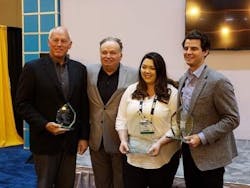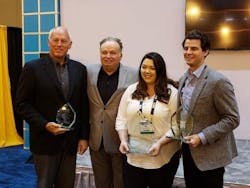2020 ATSSA Traffic Expo rundown
Now that the 2020 ATSSA Traffic Expo—a 50th anniversary gathering of the best and brightest in traffic safety and road safety technology developments—is part of the record books, it all feels like it passed rather quickly, though for those several days in New Orleans this January engagement was high and traffic (no pun intended) was steady.
Roads & Bridges Media was on hand, as always, both on the expo floor and in the curated education and discussion sessions—and there was much to glean from what we heard and saw.
First and foremost, the annual New Products Rollout took place throughout the exhibit hall’s open hours, showcasing several interesting and dynamic new developments in the traffic safety segment. Among the highlights was Innovation Award winner Royal Innovative Solutions, whose Virtual Reality Training programs offer simulated training of myriad real-life work zone scenarios, from placing and retrieving traffic cones to setting up a full work zone, all with adjustable traffic speed conditions and relative proximities. We also had the opportunity to visit with Nite Beam Products and Haltzgloves LLC, which had on display their latest work wear safety items. While workers can, on occasion, not be fully in control of the work zone environment, they can be in control of their physical presence on the jobsite, and that measure of control starts with highly reflective, properly worn work wear. It was good to see booths such as these enjoying high traffic volumes among the larger footprints.
The Education track this year was particularly worthwhile, and despite the concurrence of sessions that is an inevitability at such conventions, there was much to observe and learn from.
In a panel session that addressed what impact driving automation will have on traffic engineering over the next decade, 3M’s Fuat Aktan was adamant that a primary task must be the bringing of our present infrastructure up to such standards of safety and good repair that the application of ever-increasing automation should be seamless; no matter where you are—from the snowy roads of northern Wisconsin to the baking tarmac of southern Florida—the importance of standardized lane markings should be a top goal for all road and bridge system planners.
The panel came to consensus that three areas in which driving automation will impact first and hardest are (the aforementioned) lane markings, work zones, and signal systems/intersections. Mercer Strategic Alliance’s Robert Dingess, the panel’s moderator, offered a realistic outlook on the automated future, saying the big talk around driverless vehicles mingling with your uncle’s ‘02 Camry on urban expressways is much further off than perhaps anyone with skin in the game would like to admit. Still, it was refreshing to listen to the panelists—which also included Road Infrastructure’s Paul Carlson and Toyota’s Ed Bradley, as well as Doug Campbell of the Automotive Safety Council—offer cogent and cautious estimates of our automated future. Each espoused the safety and life-saving benefits of vehicle automation, but unlike panels I have attended in the past where OEM reps basically talked up their product, here the focus was on offering sound advice to the traffic planners in the audience struggling with how to fund their road network programs in the face of the automated and driverless future.
Another educational session of note was “Safer Roads Through Connected Vehicle Technology” presented by Peter Jager, P.E., PTOE, a traffic signal engineer with the Utah DOT (UDOT). Jager discussed his agency’s work with connected and automated vehicle (CAV) technology, which is central to UDOT’s Transportation Technology Group, IntelliMove Utah—a program designed to foster a culture of innovation around new technologies that improve traffic management and safety. Jager discussed how the agency’s work with CAV technology is helping to drive down an already declining fatality trend in the state of Utah. This is being achieved, for instance, through the Utah Transit Authority’s (UTA) deployment of automated vehicle shuttle pilot programs in several locations. Additionally, it was noted that UDOT had participated in the National Connected Vehicle SPaT Deployment Challenge—issued by the Vehicle to Infrastructure Deployment Coalition—a challenge to state DOTs and other transportation agencies to deploy roadside Dedicated Short Range Communications (DSRC) to broadcast signal phase and timing (SPaT) in real-time at signalized intersections on at least one road corridor of 20 signals in each state by January 2020. UDOT rose to the challenge with the Redwood Road DSRC Corridor, the nation’s first operational deployment of CAV technology. This system helped UTA buses arrive on time at bus stops along Redwood Road in the Salt Lake City area. Using the DSRC radios, UTA buses and traffic signals at each intersection have been able to communicate with each other. Jager also discussed the UTA’s work with the Utah Valley Express (UVX) Provo-Orem bus rapid transit (BRT) line, a 10.5-mile corridor that has implemented DSRC on 47 intersections and 25 buses, which has been in operation since December 2018.
The 2020 ATSSA Traffic Expo closed out with the announcement of the winners of the annual Innovation Awards, which are meant to recognize the products that contribute to the industry’s mission of advancing roadway safety and working Toward Zero Deaths. First, second, and third-place recipients were chosen out of the 20 products chosen for review in the New Products Rollout. Third place went to VER-MAC from Quebec, Canada, for its Smart Arrow Board/Work Zone Location Sensor System, which is designed to inform government agencies and the motoring public they are entering a work zone. Second place went to Pi Variables from Tustin, California, for its product AIMS, which is a small electronic device that attaches to any attenuator and, upon impact, sends a text message and email to predefined personnel. Finally, as previously mentioned, the first place designation was bestowed upon Royal Innovative Solutions from Coopersburg, Pennsylvania, for its Virtual Reality Training.
For a complete breakdown of every product in this year’s New Products Rollout, visit roadsbridges.com/videos or traffictransit.com/videos.

